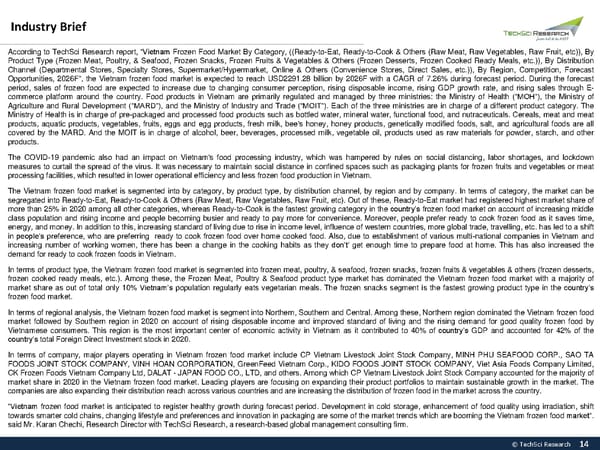Industry Brief According to TechSci Research report, “Vietnam Frozen Food Market By Category, ((Ready-to-Eat, Ready-to-Cook & Others (Raw Meat, Raw Vegetables, Raw Fruit, etc)), By Product Type (Frozen Meat, Poultry, & Seafood, Frozen Snacks, Frozen Fruits & Vegetables & Others (Frozen Desserts, Frozen Cooked Ready Meals, etc.)), By Distribution Channel (Departmental Stores, Specialty Stores, Supermarket/Hypermarket, Online & Others (Convenience Stores, Direct Sales, etc.)), By Region, Competition, Forecast Opportunities, 2026F”, the Vietnam frozen food market is expected to reach USD2291.28 billion by 2026F with a CAGR of 7.26% during forecast period. During the forecast period, sales of frozen food are expected to increase due to changing consumer perception, rising disposable income, rising GDP growth rate, and rising sales through E- commerce platform around the country. Food products in Vietnam are primarily regulated and managed by three ministries: the Ministry of Health (“MOH”), the Ministry of Agriculture and Rural Development (“MARD”), and the Ministry of Industry and Trade (“MOIT”). Each of the three ministries are in charge of a different product category. The Ministry of Health is in charge of pre-packaged and processed food products such as bottled water, mineral water, functional food, and nutraceuticals. Cereals, meat and meat products, aquatic products, vegetables, fruits, eggs and egg products, fresh milk, bee's honey, honey products, genetically modified foods, salt, and agricultural foods are all covered by the MARD. And the MOIT is in charge of alcohol, beer, beverages, processed milk, vegetable oil, products used as raw materials for powder, starch, and other products. The COVID-19 pandemic also had an impact on Vietnam's food processing industry, which was hampered by rules on social distancing, labor shortages, and lockdown measures to curtail the spread of the virus. It was necessary to maintain social distance in confined spaces such as packaging plants for frozen fruits and vegetables or meat processingfacilities, which resulted in lower operational efficiency and less frozen food production in Vietnam. The Vietnam frozen food market is segmented into by category, by product type, by distribution channel, by region and by company. In terms of category, the market can be segregated into Ready-to-Eat, Ready-to-Cook & Others (Raw Meat, Raw Vegetables, Raw Fruit, etc). Out of these, Ready-to-Eat market had registered highest market share of more than 25% in 2020 among all other categories, whereas Ready-to-Cook is the fastest growing category in the country’s frozen food market on account of increasing middle class population and rising income and people becoming busier and ready to pay more for convenience. Moreover, people prefer ready to cook frozen food as it saves time, energy, and money. In addition to this, increasing standard of living due to rise in income level, influence of western countries, more global trade, travelling, etc. has led to a shift in people’s preference, who are preferring ready to cook frozen food over home cooked food. Also, due to establishment of various multi-national companies in Vietnam and increasing number of working women, there has been a change in the cooking habits as they don’t’ get enough time to prepare food at home. This has also increased the demandforreadyto cookfrozen foods in Vietnam. In terms of product type, the Vietnam frozen food market is segmented into frozen meat, poultry, & seafood, frozen snacks, frozen fruits & vegetables & others (frozen desserts, frozen cooked ready meals, etc.). Among these, the Frozen Meat, Poultry & Seafood product type market has dominated the Vietnam frozen food market with a majority of market share as out of total only 10% Vietnam’s population regularly eats vegetarian meals. The frozen snacks segment is the fastest growing product type in the country’s frozen food market. In terms of regional analysis, the Vietnam frozen food market is segment into Northern, Southern and Central. Among these, Northern region dominated the Vietnam frozen food market followed by Southern region in 2020 on account of rising disposable income and improved standard of living and the rising demand for good quality frozen food by Vietnamese consumers. This region is the most important center of economic activity in Vietnam as it contributed to 40% of country’s GDP and accounted for 42% of the country’s total Foreign Direct Investment stock in 2020. In terms of company, major players operating in Vietnam frozen food market include CP Vietnam Livestock Joint Stock Company, MINH PHU SEAFOOD CORP., SAO TA FOODSJOINTSTOCKCOMPANY,VINHHOANCORPORATION, GreenFeed Vietnam Corp., KIDO FOODS JOINT STOCK COMPANY, Viet Asia Foods Company Limited, CKFrozenFoodsVietnamCompanyLtd,DALAT-JAPANFOODCO.,LTD,andothers.AmongwhichCPVietnamLivestockJointStockCompanyaccountedforthemajorityof market share in 2020 in the Vietnam frozen food market. Leading players are focusing on expanding their product portfolios to maintain sustainable growth in the market. The companiesarealso expanding their distribution reach across various countries and are increasing the distribution of frozen food in the market across the country. “Vietnam frozen food market is anticipated to register healthy growth during forecast period. Development in cold storage, enhancement of food quality using irradiation, shift towards smarter cold chains, changing lifestyle and preferences and innovation in packaging are some of the market trends which are booming the Vietnam frozen food market”. said Mr. Karan Chechi, Research Director with TechSci Research, a research-based global management consulting firm. © TechSci Research 14
 Vietnam Frozen Food Market 2026 Page 13 Page 15
Vietnam Frozen Food Market 2026 Page 13 Page 15